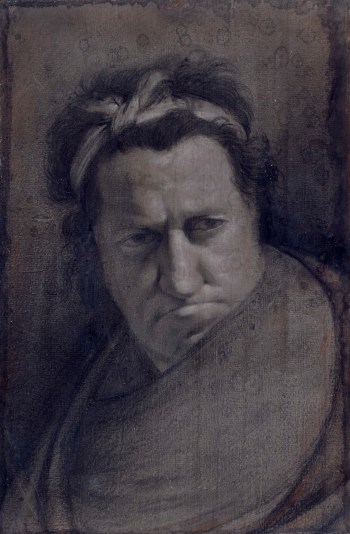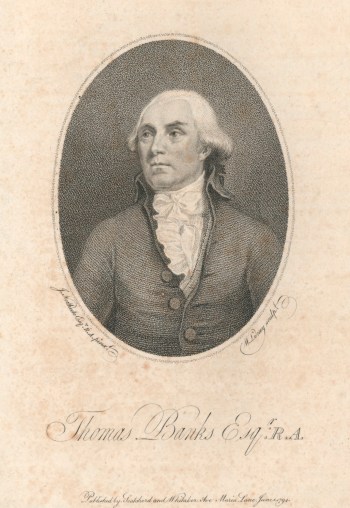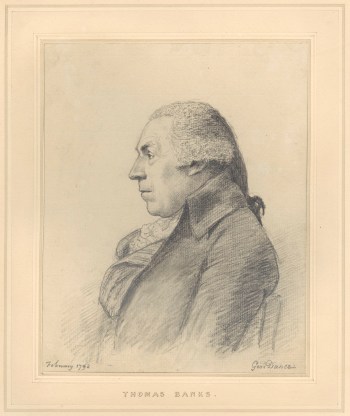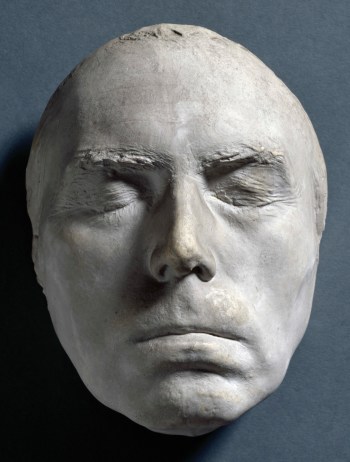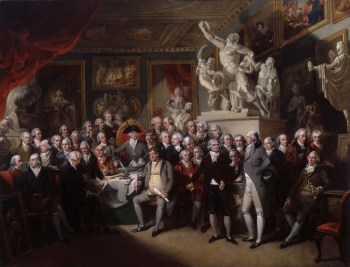Thomas Banks RA (1735 - 1805)
RA Collection: People and Organisations
A founding father of the British school of art, Thomas Banks was the most original of British neo-classical sculptors.
Born in London in 1735, Banks was educated in Ross-on-Wye, near Badminton where his father, a landscape gardener, was working. He was then apprenticed to a mason and woodcarver in London, while at the same time studying in the studio of the sculptor Peter Scheemakers. He also enrolled in the St Martin’s Lane Academy, and exhibited at the Free Society of Artists during the 1760s.
In 1769 Banks was admitted to the Royal Academy Schools. He first exhibited at the Royal Academy in 1770, the same year he became the first sculptor to receive the Academy’s travelling scholarship to Rome. Banks lived in Rome (where his friends included Henry Fuseli) between 1772 and 1779 before returning to England due to a combination of illness and financial disappointments.
Banks early career coincided with the age of patriotic patronage and he was driven by the desire to realise large-scale projects. This took him to St Petersburg in 1781, where he where he sold a statue of Cupid to Catherine the Great and obtained further commissions from her. It may have been worsening diplomatic relations between England and Russia which caused him to return home the following year. In England Banks was able to partially realise his ambitions through a number of commissions for church memorials (including a vast monument to Sir Eyre Coote in Westminster Abbey). He was also a notable sculptor of portrait busts.
In 1785 Banks was elected as a Royal Academician, and presented as his Diploma Work the marble Falling Titan which he later claimed was based on sketches made with Fuseli in Rome. He was also a notable collector of old master drawings, many of which were later acquired by Sir Thomas Lawrence. Problematically, Banks had democratic sympathies – these led to his arrest on suspicion of treason in 1794, and the withdrawal of a bust of Oliver Cromwell from the 1803 RA exhibition. Banks died in 1805 and became the first sculptor to have a tablet erected in his name in Westminster Abbey. His admirer, the Academician John Flaxman, was prevented from reading a lecture on Banks shortly after his death for fear of angering the king!
Profile
Born: 22 December 1735 in London, England, United Kingdom
Died: 2 February 1805
Nationality: British
RA Schools student from 30 June 1769
Elected ARA: 8 November 1784
Elected RA: 15 February 1785
Gender: Male
Preferred media: Sculpture
Works by Thomas Banks in the RA Collection
4 results
-
![Thomas Banks RA, Etchings, by & from the most esteem'd English artists]()
Thomas Banks RA
The Falling Titan, c. 1795
Etching
-
![Thomas Banks RA, Portrait of John Malin]()
Thomas Banks RA
Portrait of John Malin, ca. 1768-69
Black and red chalks, heightened with white, on laid paper on canvas
-
![Thomas Banks RA, The Falling Titan]()
Thomas Banks RA
The Falling Titan, 1786
Marble
-
![Thomas Banks RA, Anatomical Crucifixion (James Legg)]()
Thomas Banks RA
Anatomical Crucifixion (James Legg), 1801
Plaster cast, early 19th century
Works after Thomas Banks in the RA Collection
2 results
Works associated with Thomas Banks in the RA Collection
6 results
-
![James Northcote RA, Thomas Banks Esq. R.A.]()
After James Northcote RA
Thomas Banks Esq. R.A., 1 June 1794
Stipple engraving
-
![George Dance RA, Portrait of Thomas Banks, R.A.]()
George Dance RA
Portrait of Thomas Banks, R.A., February 1793
Pencil and black chalk (?) on cream laid paper
-
![unidentified maker, Life mask of Thomas Banks, R.A.]()
unidentified maker
Life mask of Thomas Banks, R.A., ca. 1790
Plaster
-
![James Northcote RA, Portrait of Thomas Banks, R.A.]()
James Northcote RA
Portrait of Thomas Banks, R.A., 1792
Oil on canvas
-
![Henry Singleton, The Royal Academicians in General Assembly]()
Henry Singleton
The Royal Academicians in General Assembly, 1795
Oil on canvas
-
![Unidentified Roman sculptor, Cast of front panel of Roman sarcophagus of the Muses]()
After Unidentified Roman sculptor
Cast of front panel of Roman sarcophagus of the Muses, late 18th century
Plaster cast
Associated books
3 results
-
John Britton
The fine arts of the English school; illustrated by a series of engravings, from paintings, sculpture, and architecture, of eminent English artists: with ample biographical, critical, and descriptive essays, by various authors; edited and partly written by John Britton, F.S.A. - London: 1812
07/695
-
William Shakespeare
The Dramatic Works Of William Shakspeare Revised By George Steevens. Vol. I. (- IX.) - London: -: [1802]
04/3206
-
Richard Morton Paye
Etchings, by & from the most esteem'd English artists - [s.l.]: c.1875]
05/341
Associated archives
25 results
-
L. Forster, Paris, Sir T. Lawrence
31 Aug [1829]
Item LAW/5/360/1
-
Memorandum by Thomas Banks relating to the monument of Governor Loten
c. 1790
Item JU/2/10
-
Lavinia Forster, 58 South Audley Street, to Ozias Humphry
[1804]
Item HU/6/101
-
Ozias Humphry, Cape Town, Cape of Good Hope, to Mary Boydell, at Alderman Boydell's, 90 Cheapside, London
16 May 1785
Item HU/3/30

